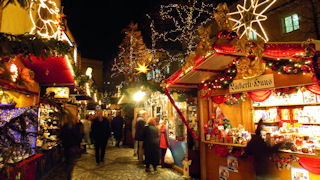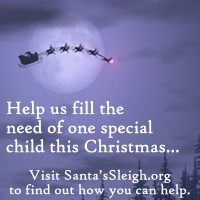Christmas Around the World — Switzerland
 Switzerland is one of the most diverse countries on the planet. It has four official languages: German, French, Italian, and Romansh (a mixture of Latin, Italian, and German). It has three religions: Roman Catholic, Protestant, and Muslim. It also has four cultural regions: Swiss-Germain (northern, eastern, and central portions), French (west), Italian (southern), and Romansh (the mountainous region of the southeast). This leads to a country with different Christmas traditions; but, even when the traditions are similar, there are small differences that make the Christmas celebration unique to that area of Switzerland.
Switzerland is one of the most diverse countries on the planet. It has four official languages: German, French, Italian, and Romansh (a mixture of Latin, Italian, and German). It has three religions: Roman Catholic, Protestant, and Muslim. It also has four cultural regions: Swiss-Germain (northern, eastern, and central portions), French (west), Italian (southern), and Romansh (the mountainous region of the southeast). This leads to a country with different Christmas traditions; but, even when the traditions are similar, there are small differences that make the Christmas celebration unique to that area of Switzerland.
People all over the world love to count down the days to Christmas Day. Children and other people all over Switzerland use some form of Advent calendar (calendars filled with chocolate pieces are favorites). In the Swiss-German region of Switzerland, many households celebrate Advent. Beginning four weeks before Christmas, the first candle is lit followed each Sunday with the lighting of an additional candle. As each candle is lit, children may receive nuts, tangerines, and other treats. Families may also start working on crafts such as nativity figurines, straw ornaments, and candles for Christmas.
In every city, town, village, and in many homes, the smells of Christmas begin tickling the nose. Cookies are being made in the bakeries and kitchens all over. In the Swiss-German region, spiced honey cookies (called Labchueche, Lackerli, or Biberli) flavored with orange peel and filled with almond paste and lemon zest and topped with paper showing seasonal pictures. They also make small anise-flavored breads called Anisbrotli which are pressed into molds carved with Alpine flowers or elaborate landscapes. Spiced chocolate and hazelnut cookies called Basler Brunsli are often found in the shape of hearts. Mailanderli are golden sugar cookies that are butter flavored and contain no spices. In the Romansh region, Churer Zimmetstern, a star-shaped cinnamon cookie with a sweet meringue glaze, and Chrabeli, a hard, white anise-flavored cookie, are made for everyone’s enjoyment.
On December 5, Roman Catholic children leave their shoes outside and find them, the next morning, filled with Christmas goodies left by St. Nicholas. In the Italian region, San Nicola or Babbo Natale leaves small goodies for the children.
On December 6, many towns and villages, especially in Roman Catholic regions, celebrate St. Nicholas Day. St. Nicholas arrives to parades, contests, and lots of children. He may arrive dressed like the American Santa Claus or dresses in bishop’s robes with a miter on his head carrying a shepherd’s crook. He may not appear in a sleigh but riding a donkey, riding a motorcycle, flying in a helicopter, or on foot leading crowds of children. Children can find him in town squares, department stores, or visiting children’s homes giving out bags of goodies to the good children.
In most regions of Switzerland, Christmas trees can be found in the homes. They are lit with real candles and ornamented with gold and silver garlands, colorful ornaments, cookies, nuts, fruit, foil-wrapped chocolates, and small presents. A star or angel tops the wonderful sight. In homes in the Swiss-German region Christmas trees are put up and decorated secretly by the parents. The children get their gifts when the tree is revealed for them to see in all its glory.
Families decorate their homes with all sorts of evergreen boughs. Inside, the presepio or nativity scene is put up in a prominent place. Figures of Mary, Joseph, the shepherds, animals, and towns people may be placed around the stable waiting for Gesu Bambino, the baby Jesus. In the Romansh region, the nativity scene is joined by a Christmas tree. Churches also decorate with presepios.
Cities get into the spirit of the season lighting up their city squares and shopping districts. Zurich also puts on special events for the children. In December, the children of Zurich make paper boats and put candles in them and float them down the Limmat River to wish everyone a Merry Christmas. The city also brings out an antique trolley decorated with Christmas colors and images. The trolley is driven by Samichlaus (Santa Claus) who picks up children who listen to Christmas stories during their ride.
Caroling may be heard in the streets of many Swiss cities, town, and villages. Carolers are often accompanied by townsfolk dressed as Mary, Jesus, Joseph, and the three wise men. “Silent Night” is a favorite carol.
Christmas markets start popping up in many cities, towns, and villages. Some of these markets are up for the whole Christmas season, while others may only open for a weekend or two. The markets comprise of wooden stalls or chalets surrounded by thousands of twinkling lights. The markets may also display Christmas trees, have an ice rink for all to enjoy, or themed Christmas ideas such as a medieval Christmas market. These markets are great for finding the perfect gift for someone while eating and acquiring Christmas treats for sharing at home and taking a relaxing stroll. Shoppers can find ornaments for their Christmas tree, wood carvings, hand-dipped candles, woolen scarves and sweaters, gingerbread, chocolates, pastries, sausages, soups, and, of course, hot chocolate.
Some towns, like Basel, have Christmas stores to shop at. The Johann Wanner Christmas House offers glass Christmas ornaments, cards, lights, tinsel strings of beads, chocolates, and small toys to grace one’s Christmas tree. At the Lackerli Huus, one may find one of the favorite cookies of the Switzerland Christmas season. Leckerli is a chewy spiced cookie made with almond, honey, dried fruit, and kirsch. One may also purchase decorative cookie jars, sweets, and other gifts.
Christmas Day in Switzerland sees several Christmas gift-givers also. A lot of gifts are brought by St. Nicholas or the Kristkindl (Christ Child). In the Italian region, gifts are brought by the Gesu Bambino. In the French region, Pere Noel (Father Christmas), resembling the American Santa Claus, may enter a window to leave gifts for the children or he may visit homes of children who then sing a song, recite a poem, or play a musical instrument before receiving their gifts.
Unlike Christmas dinner in the United States which for many consists of a large turkey dinner, there is no traditional food item that most people in Switzerland serve for their Christmas dinner. In the Romansh region, one may find ham or Bundnerfleisch, air-dried beef or game pressed into rectangular loaves and served in paper-thin slices, on their Christmas table. In the Italian region, Christmas dinner may include Polenta, a corn-meal mush dish, Brasatto, a braised beef dish, and Risotto, a rise dish. People in the Swiss-German region may enjoy meat fondues. Whatever dishes find their way on a Swiss Christmas table are made to enhance the enjoyment of the Swiss Christmas celebration.
![]()
![]()


